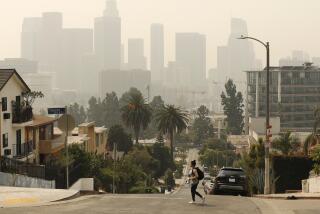Ozone Layer Still Shrinking, Scientists Find
- Share via
WASHINGTON — New data have determined that the ozone layer protecting the Earth from harmful solar radiation has continued to shrink at an unabated and unacceptable pace, government scientists reported Wednesday.
But, they said, careful adherence to an international agreement banning the production of chemicals that eat away at the protective zone can be expected to begin reducing the danger as early as the start of the next decade.
“Global ozone is declining . . . on the order of 4% per decade,” said David Hofmann, director of the National Oceanic and Atmospheric Administration’s climate-monitoring and diagnostic laboratory in Boulder, Colo.
But over the United States, the harmful decline was even greater. The ozone layer was reduced 6% below earlier measurements over the contiguous 48 states, and 10% below the standard over Alaska.
Awareness about the disappearing layer of ozone and the health dangers that the shrinkage represents has been growing over the last two decades. Increased monitoring on the ground and by satellites has added greatly to the information collected globally on the phenomenon. The report made public Wednesday builds on earlier studies, confirming initial data pointing to the ominous trend even as governments move to reduce the use of ozone-depleting chemicals.
Reporting on data gathered over the last year, the scientists said extremely cold temperatures in the stratosphere during the most recent winter over the northern latitudes had led to a sharp drop--20% to 25%--in the ozone over Northern Europe, Siberia and Greenland, as measured against a base period when initial measurements were made, from 1979 to 1986.
Their study also corroborates reports of the role played by such volcanic eruptions as those at Mt. Pinatubo in the Philippines in 1991 and of El Chichon in Mexico nine years earlier.
The eruptions wreak havoc with the ozone layer by releasing tiny particles of sulfuric acid that boost stratospheric contamination, which in turn eats away at the ozone when combined with industry-created chlorine.
Ozone is a pale blue gas with a penetrating odor. At low altitudes, it is considered a pollutant. Yet in the stratosphere, nine to 18 miles above the Earth, it has beneficial effects--screening out radiation while providing a layer of insulation that helps the planet retain warmth.
The ultraviolet radiation it absorbs is considered a factor in developing skin cancers and cataracts, and it is also considered a possible factor in human immune system disorders and reduced crop yields. As ozone is eaten away in chemical reactions fed by industry-released compounds, its wide role in protecting human health is reduced.
Earlier reports had said that chlorofluorocarbons, chlorine compounds better known as CFCs, were triggering anywhere from a 2.7% to 7% decrease in global ozone each decade.
Production of the gases, which have been used as aerosol propellants, refrigerants and in the manufacture of plastics, has been banned by an international treaty since Jan. 1. But the chlorine compounds take many years to decay.
While the reduction of the ozone layer may begin to be reversed as early as 2000, it could be 50 years before natural processes and reduced levels of chlorine in the stratosphere combine to completely reverse the losses of the late 20th century, said Alvin J. Miller of the government’s Climate Prediction Center.
The team from several agencies of the National Oceanic and Atmospheric Administration based its findings on measurements recorded at monitoring stations forming a swath across the midsection of the United States, from Fresno to Boulder, Colo., Nashville and Wallops Island, Va., as well as from data obtained by satellite.
The new authority with which experts are viewing their calculations of the impact of volcanic eruptions stems from greater understanding of the interaction between the particles spewed into the stratosphere by volcanoes and human-made chlorine.
“Recent studies of the impact of volcanic eruptions suggest that halogens and aerosols [certain gases including chlorine, and tiny particles of matter propelled into the air] have controlled much of the variations in ozone trends since 1979,” Hofmann said.






